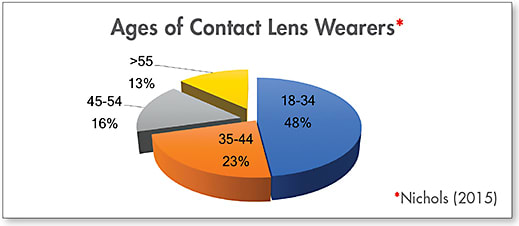Between 50% to 94% of patients reporting to their eye-care provider do so because of issues that they are having with their contact lenses (Dumbleton et al, 2013). And what are those issues? Discomfort and dryness have been reported to account for the top two reasons (Riley et al, 2006).
I have a hard time believing these numbers. But, I have to admit, perhaps I have been missing the point all along. Do you realize that nearly half of all contact lens wearers are under the age of 34 years old? The percentage of the population wearing contact lenses drops steadily with age after 34 years old, with only 13% of patients over the age of 55 still wearing their contact lenses (Nichols, 2015, Figure 1). You’re probably thinking the same thing that I’m thinking: “Oh no, not my patients. I refit them into better contact lenses and keep them in lens wear.”

But what if we are wrong? What if changing the contact lenses alone doesn’t solve the problem?
First Things First—Fit the Best Contact Lenses
As contact lens practitioners, we are always on the hunt for the best lenses possible—as we should be. I believe that our number one priority is to ensure that our patients are in the best contact lenses available. In my opinion, this would be a silicone hydrogel daily disposable lens for most patients.
But before we let patients leave to see about the outcome with the updated lenses, we’ve started to ask them a new question: Did they have this symptom in years past, or is it a new symptom? If a patient truly has a contact lens problem, then he or she should have experienced the same symptoms all along. However, if this is a new problem, then something else has changed that needs to be addressed.
Getting to the Source
If it is a new problem, I first look at the meibomian glands. As described by Blackie et al (2010), the problems that are causing patients’ symptoms can be nonobvious. The meibomian glands may appear healthy, but when evaluated with calibrated gland expression, they may not reveal any oil production. If patients have less than six glands yielding liquid secretions, I will treat them with thermal pulsation. If they have between six to 10 glands flowing, I will trial warm compresses to see whether additional gland flow can be created.
Additionally, if patients have signs of a lacrimal or goblet cell dysfunction, I will treat them with a T-cell–mediated medication (cyclosporine, lifitegrast) to positively alter their tear production.
Time to Take a New Approach
Contact lens dropout is a reality, but it doesn’t have to remain at the level at which it currently stands. It’s time for us to look at things through new eyes: dry eyes. Let’s treat the disease that our patients reveal to us and see whether we can alter our prior failure rates. CLS
For references, please visit www.clspectrum.com/references and click on document #258.





